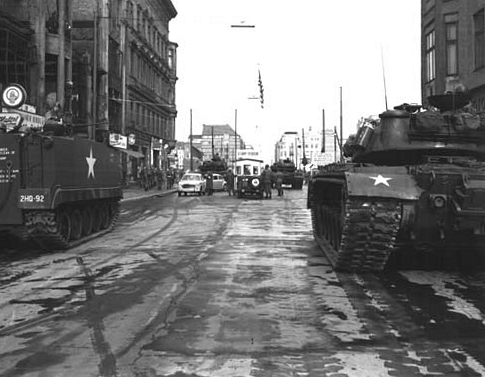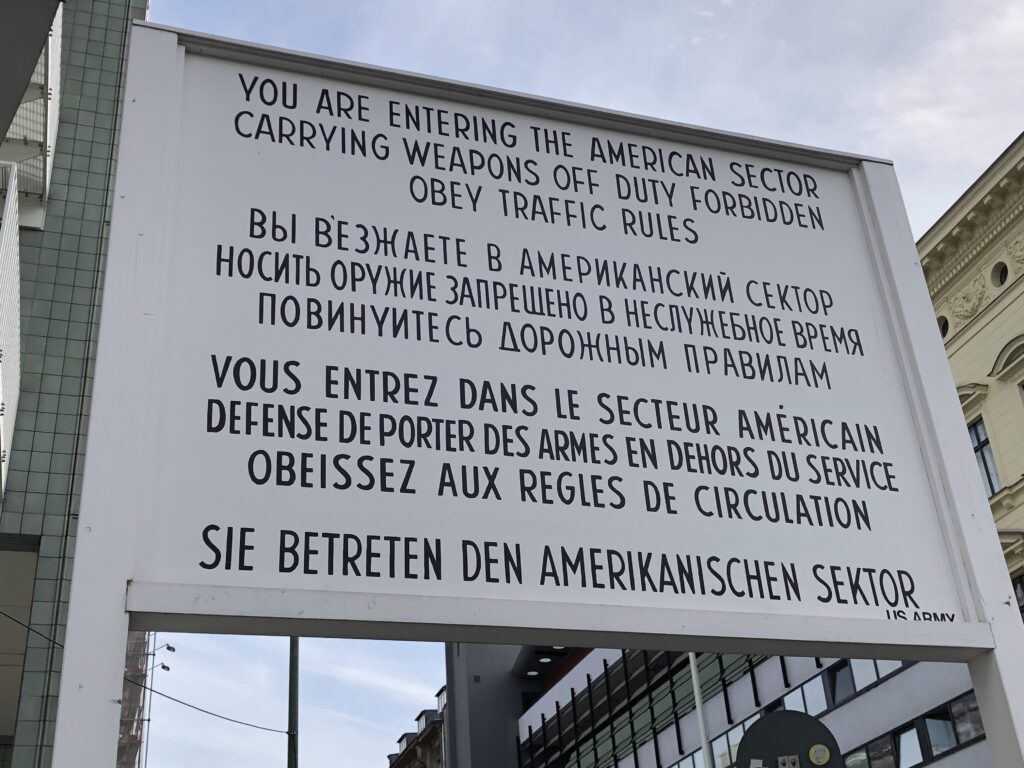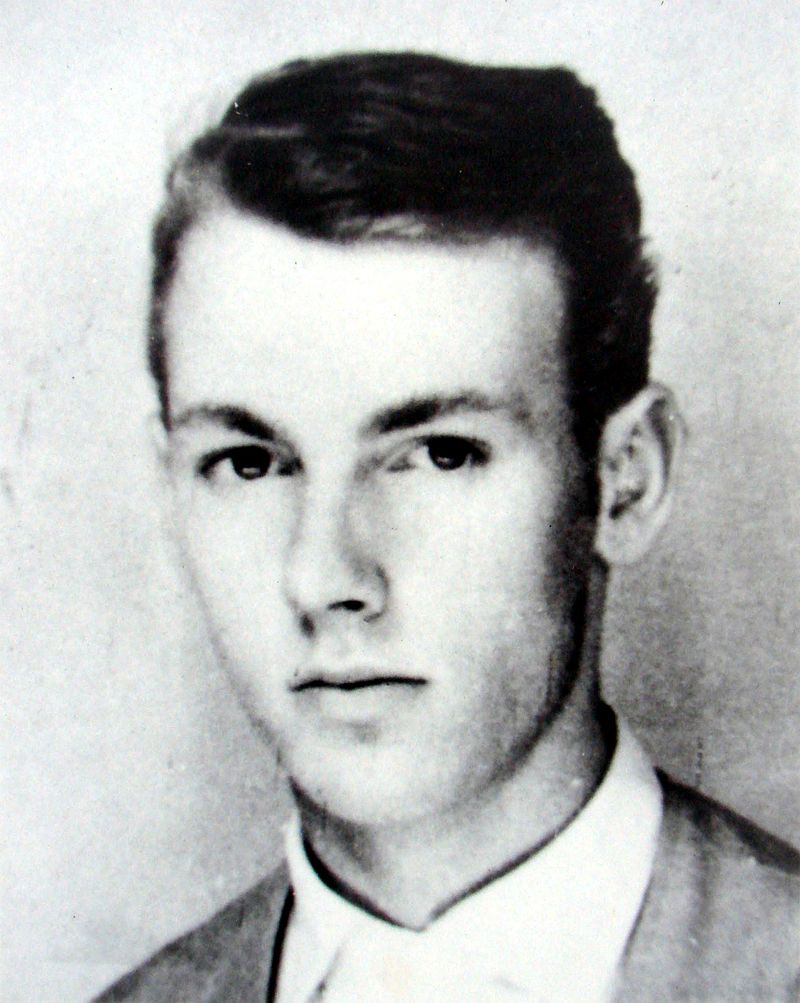
A quick internet search shows that some visitors to Berlin seemed to be disappointed with this legendary Berlin Cold War cross-roads. Not worth visiting they say. This is an outrage, no visit to Berlin is complete without crossing over Checkpoint Charlie – Berlin’s most famous intersection.
To get the best out of Checkpoint Charlie one needs to be aware of the answers to these questions:
What was Checkpoint Charlie?
Why was Checkpoint Charlie famous?
Why is Checkpoint Charlie called Charlie?
What is left of Checkpoint Charlie today?
Who could cross at Checkpoint Charlie?
Did anyone escape through Checkpoint Charlie?
Here are the answers:
What was Checkpoint Charlie?
Checkpoint Charlie became the symbol of a divided Berlin, Germany and World after WWII. In reality, it was simply one of the Berlin Wall border crossings between communist east and free west Berlin, on a street corner separating the US from the Soviet sector.
This meant Checkpoint Charlie both separated and united east and west Berlin. A strange place indeed during the Cold War.
But it was also where Soviet and American troops aimed tanks and bazookas at each other during a few crisis weeks in the autumn of 1961. During those October weeks, the world stood on the brink of World War III, vividly illustrating how Berlin’s destiny held the key to Europe’s future.

Where did Checkpoint Charlie come from?
Towards the end of WWII, Germany was physically divided on paper and then afterwards these zones were occupied and controlled by the victors, Britain, the US, and the Soviet Union. Eventually France was included in this group too.
Berlin was carved up into 4 sectors too. This was achieved by lumping together groups of the city’s 20 boroughs into two halves – the Soviet and Western sectors. They became known and ‘East’ and ‘West’ Berlin.
The East got 8 districts, the West got 12. As a result, old district boundaries, some that had been lines on the city’s map for centuries (like the line of the old mediaeval city wall for example), became the new sector boundaries.
The Berlin Wall was built on these boundaries in August of 1961, so before this, for 16 years, the city was divided only by these lines. As tensions rose between each side in the 1950s, large signs appeared, warning you as you crossed the intersections from the west into the eastern zones. In the 1950s the east of Berlin was a dangerous world. Many people who had fallen foul of the Soviets disappeared.
These lines can still be seen today, marked by cobble-stones running around the west side of the city for the full length of the Berlin wall, some 160kms.

During the 1950s, nearly 20% of East Germany’s population, often young folks, escaped to the island of freedom – west Berlin. That was nearly 3 million people in total.
So, east Germany built the Berlin wall around it, to shut the back door out of communist east Germany and Europe in 1961.
Why was it called ‘Charlie’?
At the site of Checkpoint Charlie today, there is a sign commemorating the Cold War showing a Soviet soldier and a US soldier, staring into each other’s sectors. Neither of these men is called Charlie.
There were 9 border crossing point over the Berlin Wall. Checkpoint Charlie became the most famous. It was the end of a transit road from west Germany, through east Germany, giving access to West Berlin. There were 3 border crossings on the road – called A, B and C. The military alphabet names those letters Alpha, Bravo, and of course, Charlie. That’s why Checkpoint Charlie is called ‘Charlie’.
Why is Checkpoint Charlie famous?
During the Cold War, Berlin was where east met west. As information on the enemy became the key to Cold War success, in the 50s Berlin became the spy capital of the world. This caught the frightened world’s imagination and spawned the spy film genre often featuring Checkpoint Charlie. James Bond crossed in ‘Octopussy’, Harry Palmer in ‘Funeral in Berlin’, Richard Burton in ‘The spy who came in from the cold’ and most recently, Checkpoint Charlie featured in Tom Hanks ‘Bridge of Spies’.
Another reason is that as that Charlie was the place where military personnel and foreign visitors crossed, thus it became synonymous with the Berlin ‘crossing point’ despite fact there were others.
Death at Checkpoint Charlie
In 1962 there were two news stories from Checkpoint Charlie that taught the world the real human cost and meaning of the Berlin wall one year after it was built.
An escape through a tunnel, dug from the western side to rescue relatives, ended with the death of an east German border guard. Fidel Castro laid a wreath at the memorial to this event on the eastern side on the 10thanniversary in 1972.
More vividly, an 18-year-old building worker called Peter Fechter was gunned down trying to escape at Checkpoint Charlie in August 1962. Shot and bleeding in the no man’s land, his death was captured on camera, filmed from the free western side, just a few metres away.
It took him 54 minutes to die.

Only then did east German border guards – those with access to the border zone (and of course with a chance to rescue Fechter and save his life) – remove his now lifeless body. The Fechter footage sent shock waves around the world. A memorial stands at the site today.
In the early phase of the wall, a man escaped through Checkpoint Charlie with friends by driving under the barrier from the eastern side. He was at the wheel of an Austin Healey Sprite, so low and streamlined, the barrier didn’t need to be raised or smashed through.
It became the popular photo-op venue for visiting politicians, defending freedom. JFK looked over the wall from the viewing platform here during his 1963 visit, famed for his ‘Ich bin ein Berliner’ speech. Regan visited in the early 1980s too. In 1989, the removal of the US Checkpoint Charlie building itself symbolized the end of Berlin Cold War.
WWIII at Charlie – a lucky escape.
Charlie hit the headlines globally during the 1960s. Perhaps the most significant escape was the fact that World War III didn’t break out at the crossing. In 1961 when the Berlin Wall was built it threatened to block legal access from west to east. Tensions escalated until there was a terrifying tank stand-off for 3 weeks in October 1961. The Berlin crisis. The Soviets eventually backed down and the tanks withdrew.
Charlie symbolized not only the brink of nuclear war in 1961, but also the end of Cold War tensions in 1989. In the years before, a liberalizing Soviet Union had uncoupled itself from satellite states it had occupied from 1945. These (Hungary, Poland, Czechoslovakia) now broke away and reasserted their identities and opened their long sealed borders. East Germany, totally bankrupt, reacted to huge demonstrations in major cities by announcing on November 9th 1989 that they would do this too. That night, east Germany collapsed, East Berliners entered west Berlin through Checkpoint Charlie to jubilant crowds, and the Cold War was over. Checkpoint Charlie had changed the world.
What is Checkpoint Charlie today?
It’s a cross roads again. The desire for Berlin to move beyond the years of division and painful memories of the Wall means its redeveloped. But there are free photo exhibitions, there are museums. A copy of the sign saying ‘you are leaving the American sector‘ still stands, a copy of the border hut is still there too.
The best way to enjoy Checkpoint Charlie is to know the stories. Use your imagination as you cross, remembering, that not long ago, it was step that used to take you from one world to another, more dangerous world, where anything could happen and the future of our world was at stake.
